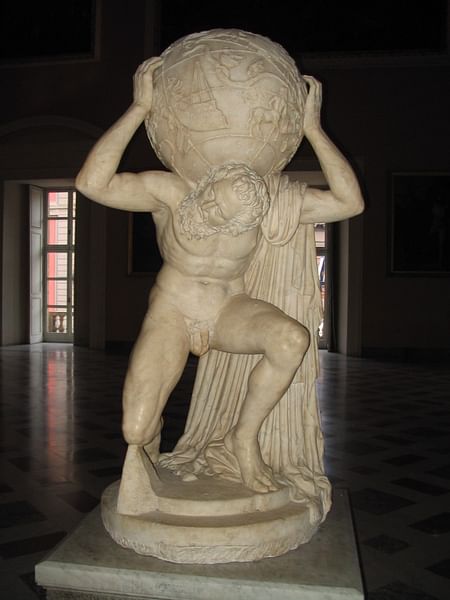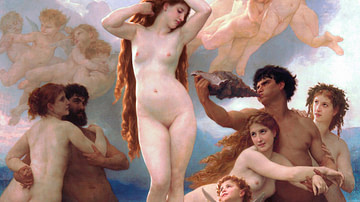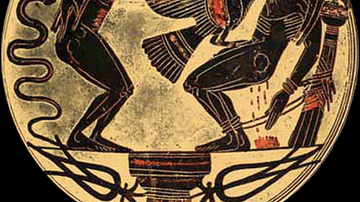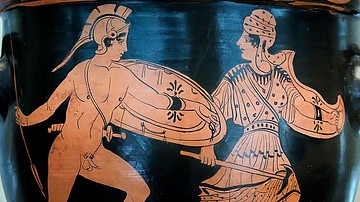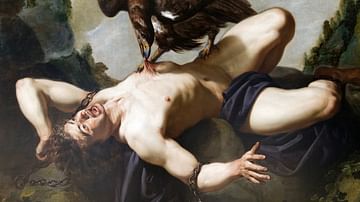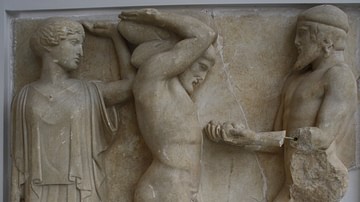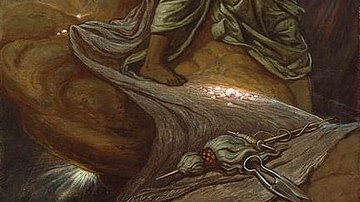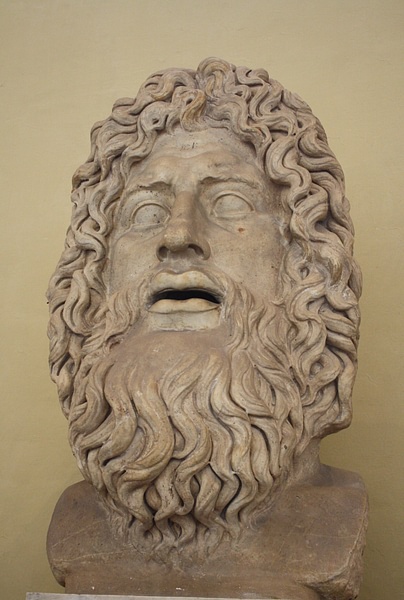
In Greek mythology the terrible and powerful Titans were those deities which preceded the Olympian gods. Never worshipped as the other gods, they nevertheless helped, through contrast, to clarify the position in the universe of the Olympian gods who defeated the unruly and chaotic Titans in the Titanomachy. Indeed, the very name Titan signifies 'Strainers', referencing their constant struggle against the order of things. Following this clash between the two generations of gods, Zeus imprisoned the Titans in Tartarus, the deepest part of the Underworld and established order in the universe.
The First Gods
The principal source of our knowledge of the primeval gods is Hesiod's Theogony. The first forces in Greek cosmology were Chasm, Earth (Gaia) and Love (Eros). From these sprang Night, Day and Erebus (Darkness). From Gaia came Sky (Ouranos or Uranus), the Nymphs and Pontus (the Sea). The union of Earth and Sky created the one-eyed Cyclopes: Brontes (Thunder), Steropes (Lightening) and Arges (Bright) and the three Hecatoncheires (Briareos, Cottus and Gyges), giants with 100 hands, 50 heads and blessed with a prodigious strength.
The Twelve Titans
Hesiod goes on to describe twelve more children of Gaia and Ouranos, the unruly Titans:
- Coeus - with Phoebe he was the father of Leto.
- Crius - with Eurybia he was the father of Pallas, Astraeus and Perses.
- Cronus - with Rhea he was the father of the Olympian gods Hestia, Demeter, Hera, Hades, Poseidon and Zeus, the youngest child. He was the subject of ancient cult worship at Olympia and a harvest festival, the Cronia, in Athens.
- Hyperion - with Theia he was the father of the Sun (Helios), Moon (Selene) and Dawn (Eos).
- Iapetus - with Themis (in some accounts Clymene or Asia) he was the father of Prometheus (Forethought), Epimetheus (Afterthought), Atlas and Menoetius.
- Mnemosyne - with her nephew Zeus, was mother of the Muses.
- Oceanus - the eldest Titan, with Tethys he was the father of the Oceanids and the various river-gods (including Nile and Styx) and himself represented the river or ocean which encircled the world and was the source of all other rivers.
- Phoebe - mother of Hecate and Asteria.
- Rhea
- Tethys
- Theia
- Themis - second wife of Zeus with whom she bore the Fates, the Hours, Eunomia (Good order or Lawfulness), Dike (Justice) and Eirene (Peace). She is associated with justice, law and prophecy.
The Titanomachy
Following Ouranos' harsh imprisonment of the Cyclopes and the Hecatoncheires, Cronus led the Titans in a rebellion against their father, an act wholly encouraged by Gaia. Indeed, Gaia gave Cronus the sickle (harpe) with which he castrated Ouranos. Throwing the genitalia into the sea (in some versions of the myth) led to the birth of the goddess Aphrodite and from the splashed blood of Cronus sprang the Erinyes (Furies), Giants and Fates.
Fearing a prophecy that his children would likewise usurp his dominance of the universe, Cronus swallowed all of his offspring. Only Zeus, spirited away by his mother Rhea to a cave on Crete, escaped this fate. To deceive Cronus, Rhea gave her husband a substitute stone wrapped in swaddling-clothes which the Titan duly swallowed. Zeus would have his revenge though, and would later make his father cough all of his siblings back into the world.
The ensuing battle between the Titans and the Olympians to gain control of the heavens was said to have lasted ten years with the Titans based on Mt. Othrys and the Olympians on Mt. Olympus in Thessaly. The Olympian gods benefitted from the aid of the Cyclopes who also gave Zeus his thunder and lightning bolts. However, what finally tipped the balance of power in favour of the Olympians was the intervention of the three Hecatoncheires, who relentlessly threw enormous boulders at the Titans. The Titans were then imprisoned in a great chasm in the deepest, darkest part of the Underworld - Tartarus - which was even deeper than Hades and henceforth became known as a place of punishment. With massive bronze gates made by Poseidon and with Gyges, Cottus and Briareos set as guards, the Titans could now no longer threaten the peaceful order established by the Olympian gods.
